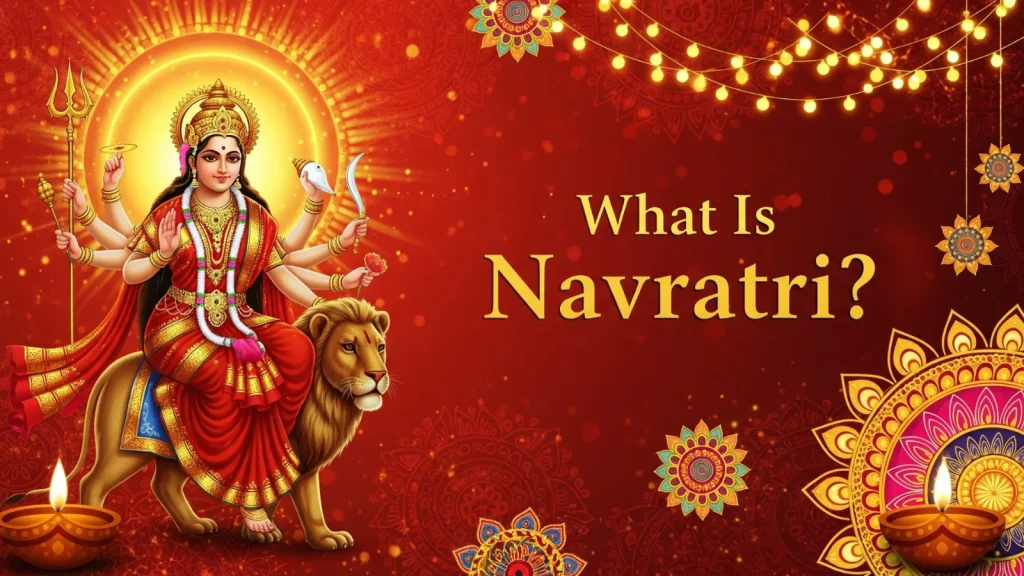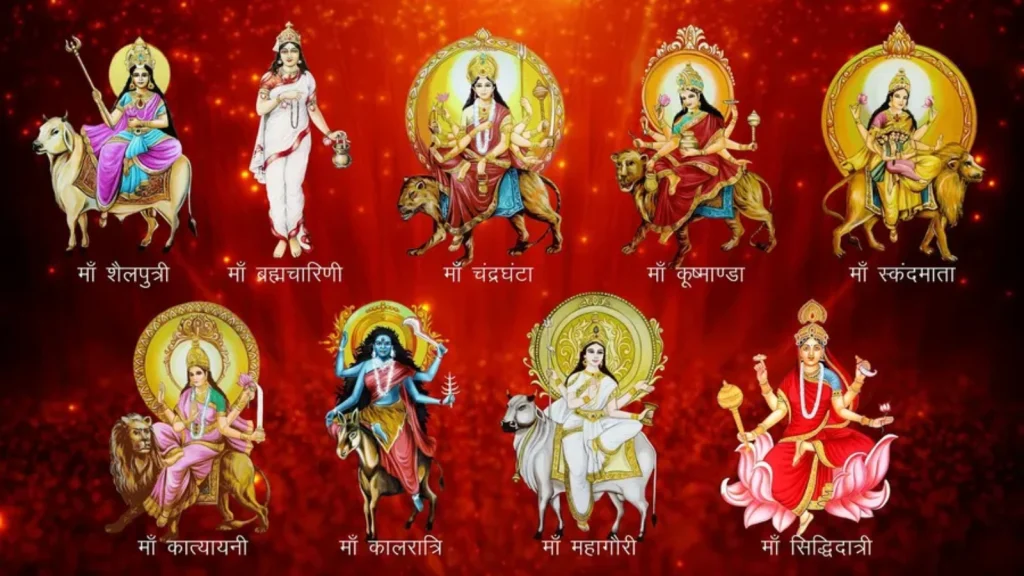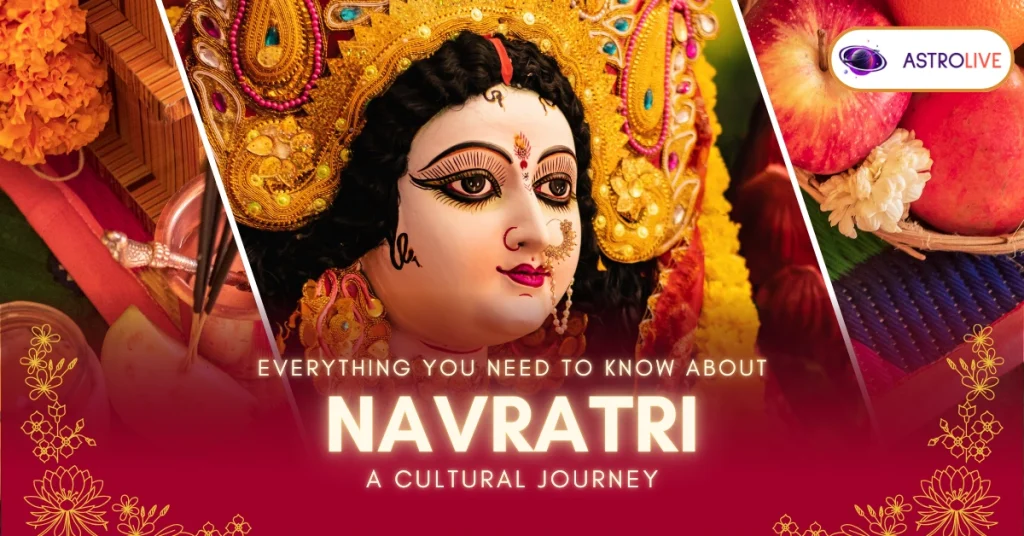Navratri is a nine-night Hindu festival dedicated to Goddess Durga and her nine divine forms, celebrated with great enthusiasm across India, especially in Gujarat, Maharashtra, and West Bengal. Falling in September or October, it combines spiritual devotion with cultural vibrancy, featuring prayers, fasting, traditional dances like Garba and Dandiya, colorful attire, music, and community gatherings.
The festival holds deep spiritual significance as a time for inner cleansing, devotion, and connecting with divine feminine energy, or Shakti. It allows people to seek strength, wisdom, and blessings while celebrating shared traditions. For Hindus across India and worldwide, Navratri is more than a festival, it’s a celebration of unity, hope, and spiritual energy that brings joy and inspiration every year.
What Is Navratri?

Navratri, means “Nine Nights” in Sanskrit, is a significant Hindu festival that spans nine nights and ten days, dedicated to worshiping Goddess Durga and her nine forms. Each day of Navratri is associated with a different form of the goddess and a specific vibrant and spiritual atmosphere. It’s not just a festival- it’s a time of devotion, prayer, music, and spiritual reflection.
Navratri holds profound significance in Hinduism, celebrating the divine feminine energy and triumph of good over evil. The festival spans nine days, each honoring a different form of Goddess Durga, symbolizing strength, wisdom, and compassion. Through rituals like fasting, meditation, and prayer, devotees seek spiritual growth, self-purification, and a deeper connection with the divine.
Spiritually, Navratri symbolizes the victory of good over evil. It marks the triumph of Goddess Durga over the demon Mahishasura, reminding us that truth and righteousness always win in the end. Culturally, it brings people together- families, communities, and entire cities join in the celebrations with garba dances, colorful outfits, delicious food, and beautifully decorated temples and homes.
What Is The Mythological Significance Of Navratri?
Navratri holds deep mythological importance, primarily linked to Goddess Durga’s victory over the demon Mahishasura. Mahishasura, granted a boon that no man or god could kill him, terrorized the worlds until the gods combined their powers to create Durga. She battled him for nine nights and triumphed on the tenth day, celebrated as Vijayadashami or Dussehra, symbolizing the victory of good over evil.
Another legend connects Navratri to Lord Rama, who worshipped Goddess Durga for nine days before defeating the demon king Ravana on the tenth day. These stories highlight courage, devotion, and divine strength. Through prayers, fasting, and festivities, devotees honor the goddess while celebrating bravery, faith, and the power of righteous intentions.
What Are The Different Types Of Navratri Celebrations?
Here are the four different types of Navratri celebrations throughout the year, each with its significance:
1. Sharad Navratri:
Sharad Navratris is the most popular and widely celebrated form of Navratri, usually observed in September or October. During these nine days, devotees worship the nine divine forms of Goddess Durga, each symbolizing different qualities like strength, wisdom, and compassion. It honors Goddess Durga and her nine forms. It ends with Vijayadashami or Dussehra.
2. Chaitra Navratri:
Chaitra Navratri takes place in March or April during the spring season; it marks the beginning of the Hindu New Year in several parts of India, especially in North India. Over these nine days, devotees worship the nine forms of Goddess Durga with deep devotion. People observe fasts, offer prayers, chant mantras, and read sacred texts like the Durga Saptashati. This Navratri not only celebrates the divine feminine but also symbolizes a fresh start, making it a spiritually uplifting time for devotees.
3. Magha Navratri:
Held in January or February, this Navratri is lesser-known and mainly observed by spiritual seekers and devotees. Unlike the more popular Sharad and Chaitra Navratri, it doesn’t involve large public celebrations. It culminates on the day of Vasant Panchami.
4. Ashadha Navratri:
Ashadha Navratri, also known as Gupt Navratri, takes place in the months of June or July, during the monsoon season. People use this time for deep meditation, secret rituals, and spiritual practices aimed at inner transformation and awakening divine energy.
What Are The Most Important Navratri Rituals And Practices?

Navratri comes with special rituals and customs that devotees follow with deep devotion. On the first day, people begin with Ghatasthapana, which means setting up a Kalash (sacred pot) filled with water, mango leaves, and a coconut. They place it on a layer of soil and sow barley seeds around it. This pot represents the goddess and stays in the prayer area for all nine days.
Every day, people worship a different form of Goddess Durga, known as Navadurga.
Each day is dedicated to one form, and each goddess represents a unique quality and power:
Day.1 Shailputri – She is the daughter of the mountains and rides a bull. She represents strength and purity.
Day.2 Brahmacharini – This form symbolizes devotion and penance. She walks barefoot and holds a rosary and a water pot.
Day.3 Chandraghanta – Known for her bravery, she wears a half-moon on her forehead and fights evil forces.
Day.4 Kushmanda – She is believed to have created the universe with her divine smile and brings light and energy.
Day.5 Skandamata – The mother of Lord Kartikeya (Skanda), she symbolizes motherly love and protection.
Day.6 Katyayani – A fierce warrior goddess, she destroys demons and removes negativity.
Day.7 Kalaratri – She has a dark appearance and fierce form. She removes fear and protects from evil.
Day.8 Mahagauri – This form represents calmness, beauty, and peace. She blesses her devotees with purity.
Day.9 Siddhidatri – The ninth form grants wisdom, success, and spiritual power.
Many people also observe fasting during Navratri. Some eat only fruits or simple meals made with ingredients like sabudana and rock salt. They avoid grains, onions, garlic, and regular salt. Fasting helps them stay focused and spiritually clean.
Throughout the festival, devotees offer special food to the goddess, like halwa, puri, and chana. Some also invite young girls (Kanya Puja) on the eighth or ninth day and serve them food, believing them to be forms of the goddess.
These rituals bring families together in devotion and create a peaceful, joyful atmosphere throughout Navratri.
Check Auspicious Timings With Today’s Panchang
What Are The Cultural Celebrations During Navratri?
Navratri is not only a religious festival but also a vibrant cultural event celebrated differently across India. Each region brings its unique customs, art forms, and traditions to the festival, making it a diverse and colorful celebration.
Garba and Dandiya Raas in Gujarat:
People in Gujarat celebrate Navratri with energetic folk dances like Garba and Dandiya Raas. They wear colorful traditional clothes and dance in circles to devotional songs every night during the nine days.
Durga Puja in West Bengal:
In West Bengal, Navratri coincides with Durga Puja. Communities set up grand pandals with artistic idols of Goddess Durga. People celebrate with music, cultural programs, feasts, and rituals.
Golu Doll Arrangement in Tamil Nadu:
Families in Tamil Nadu set up Golu steps decorated with dolls and figurines. Women invite each other for prayers, exchange gifts, and sing devotional songs.
Other Regional Variations:
People in Maharashtra perform daily prayers and join community dances, while in Himachal Pradesh, local fairs and temple rituals bring communities together. In Punjab, devotees sing devotional songs and observe fasts with great dedication, reflecting the rich cultural and spiritual diversity across these regions.
Navratri reflects India’s rich cultural diversity through these joyful celebrations.
Also Read: Gupt Navratri 2025: Significance, Date & Time
What Are The 9 Navratri Colors And What Do They Mean?
Navratri is not just a celebration of devotion but also of vibrant colours. Each of the nine days is linked to a specific color that represents the energy and mood of the goddess worshipped on that day. Devotees wear these colors with faith, believing they attract divine blessings and positivity.
Let’s understand the deeper meaning behind each color:
Day 1 – Orange: This color reflects warmth, enthusiasm, and happiness. Orange brings positive energy and marks a powerful beginning, matching the energy of Goddess Shailputri.
Day 2 – White: White shows purity, peace, and clarity. It calms the mind and reflects the serene nature of Goddess Brahmacharini, who inspires wisdom and devotion
Day 3 – Red: Red stands for passion, strength, and determination. It mirrors the fierce form of Goddess Chandraghanta, who protects her devotees and fights evil.
Day 4 – Royal Blue: This colour shows elegance and depth. It represents confidence and emotional strength, reflecting the powerful and nurturing nature of Goddess Kushmanda.
Day 5 – Yellow: Yellow symbolizes joy, sunshine, and cheerfulness. It connects with the loving and caring nature of Goddess Skandamata, who nurtures her children.
Day 6 – Green: Green represents life, growth, and harmony. It aligns with the peaceful and fearless form of Goddess Katyayani, who brings balance and courage.
Day 7 – Grey: Grey shows self-control, discipline, and calm power. It reflects the deep spiritual strength of Goddess Kalaratri, who destroys ignorance and fear.
Day 8 – Purple: Purple stands for luxury, ambition, and creativity. It highlights the rich and wise nature of Goddess Mahagauri, who blesses her devotees with peace and purity.
Day 9 – Peacock Green: This color blends serenity and freshness. It matches the grace of Goddess Siddhidatri, who grants success, wisdom, and spiritual strength.
Following these color traditions helps devotees connect deeply with the goddess’s energy and enhances the festive spirit. Plan your Navratri celebrations the most auspicious way!
Astrolive astrologers can guide you with precise pooja timings and personalized rituals for each day.
What Are The Best Foods For Navratri Fasting?
Navratri fasting focuses on eating satvik food, which keeps the body light and the mind pure. People avoid regular grains, onions, garlic, and table salt. Instead, they follow a clean, natural diet that includes easily digestible and energy-boosting ingredients. These foods not only nourish the body but also help maintain spiritual discipline.
Here are some commonly used satvik ingredients during Navratri:
- Sabudana (tapioca pearls)
- Kuttu (buckwheat flour)
- Singhara (water chestnut flour)
- Samak rice (barnyard millet)
- Potatoes, sweet potatoes
- Sendha namak (rock salt)
- Fruits and dairy products
Here are a few simple and popular fasting recipes:
- Sabudana Khichdi: Soak sabudana and cook it with peanuts, boiled potatoes, green chilies, and rock salt. It gives instant energy and keeps the stomach full for long hours.
- Kuttu Poori: Make a dough using buckwheat flour and boiled potatoes, then roll it into pooris and deep fry. Serve with curd or aloo sabzi for a filling meal.
- Samak Rice Pulao: Cook barnyard millet with vegetables like carrots and peanuts. Add cumin and ghee for taste and fragrance.
- Aloo Jeera: Boil and sauté potatoes in ghee with cumin and green chili, and serve them with curd.
- Fruit Salad or Lassi: Mix seasonal fruits or blend curd into a refreshing drink for quick energy.
These recipes keep the body energized and help maintain devotion throughout the fast. People prepare these meals with purity and offer them to the goddess before eating. Such food strengthens both the spiritual and physical aspects of Navratri.

What Are The Astrological Benefits Of Navratri?
Fasting and rituals during Navratri purify the body, mind, and aura while helping reduce the malefic effects of planets like Rahu, Ketu, Saturn, and Mars. Lighting diyas, chanting mantras, offering red flowers, and reciting Durga Saptashati align devotees with positive cosmic energies, bringing peace, prosperity, and spiritual growth.
Each day of Navratri honors a different form of Goddess Durga and corresponds to specific planetary vibrations, helping balance the Navagrahas in one’s birth chart. By performing these rituals with devotion, devotees harmonize their inner energies with universal forces. For accurate pooja timings and personalized guidance, Astrolive astrologers can provide expert insights to maximize Navratri blessings.
Conclusion
Navratri is more than a festival; it is a spiritual journey that awakens inner strength, devotion, and balance. Each ritual, from fasting to prayer, invites transformation and divine connection. By aligning with the energies of the goddess and the cosmos, we cleanse negativity and invite peace, prosperity, and clarity into our lives.
As you decorate your home, perform rituals, or dance in celebration, let your heart stay rooted in gratitude and awareness. Embrace each moment with joy and reverence. Celebrate Navratri not just with tradition, but with mindfulness and purpose, allowing its sacred energy to uplift your spirit. For precise pooja timings and personalized guidance, Astrolive astrologers can help you make the most of this divine festival.
FAQs
1. Can Navratri fasting be customized for beginners or those with health concerns?
Ans. Yes, Navratri fasting can be adapted based on health needs and personal stamina. Beginners can start with partial fasting, such as skipping one meal or avoiding only certain foods, while maintaining devotion and spiritual focus. Consulting an astrologer or nutritionist can help balance health and tradition.
2. Why is Kanya Puja performed during Navratri?
Ans. Kanya Puja, or worship of young girls, is done on the eighth or ninth day of Navratri to honor Goddess Durga in her most innocent form. It symbolizes respect for feminine energy, compassion, and purity, as devotees serve food and offer blessings to the girls.
3. How can one spiritually benefit from Navratri without performing all rituals?
Ans. Even without performing every ritual, one can gain spiritual benefits by practicing mindfulness, chanting mantras, meditating, or engaging in devotional music and prayer. The key is devotion, intention, and connecting with the energy of Goddess Durga.







